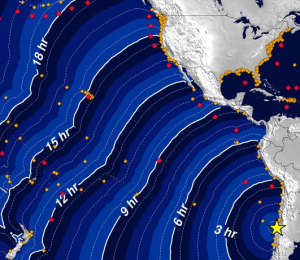

I was concerned until 8am; here’s what changed my mind:
On-line maps of wave heights arriving in French Polynesia clearly indicated even to a lay person that a significant tsunami was not possible in Hawaii. At 2,500 miles closer proximity to the event epicenter, French Polynesia reported only a 6 foot wave in the Marquesas Islands followed by a half foot in Tahiti. It isn’t possible for a tsunami to suddenly pick up strength as it moves; all models indicate the reverse happens as it loses power over time and distance.
Look at the chart below and think how you would react.
The is a screen-shot of the report I found on-line early Saturday morning. Why didn’t NOAA explain this and curtail the panic?
Even without any serious threat, NOAA’s Hawaii Tsunami Center scientists continued, based on unsubstantiated assumptions, to create unnecessary panic including hourly air raid siren blasts.
- The event fueled incessant, irrational and non-investigative traditional media fervor that went unabated well past mid-day.
- Social Media, otherwise extremely helpful in disasters such as Haiti and with this earthquake in Chile, served to only exacerbate the false alarm here in Hawaii.
- Before the bewitching hour, stores closed, and many did not reopen again. People had been so frightened by the incorrect information that many simply did not want to leave home.
- Many roads throughout Hawaii were roadblocked making transportation difficult to impossible. Statewide, police department ordered to work all officers on their day off to stop traffic.
NOAA has been apologizing, not for the panic, but for how incorrect they were. Other reports indicate that tsunami forecasting will now need to be completely reassessed.
The whole state seemed simply worn out from Saturday’s drill. One Facebook friend lamented that he wanted his Saturday back. Some say that it was a good preparatory drill while others believe say it will backfire and that next time there’s a warning, people won’t heed it.
Charles McCreery, NOAA’s Pacific Tsunami Warning Center head admitted, “we’re still in the incipient stages of using these models to constrain our forecasts. There are still lots of improvements we need to make before we can rely on them totally for our decision making.”
One of the most frightening aspects of this erroneous reporting and seriously flawed modeling is that it would seem to indicate that an error in the opposite direction could be made just as easily.
Subscribe to our email updates.
Get Breaking Hawaii Travel News
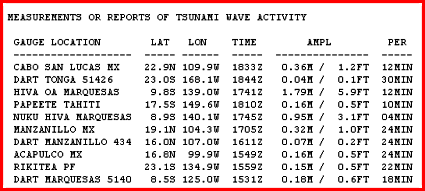
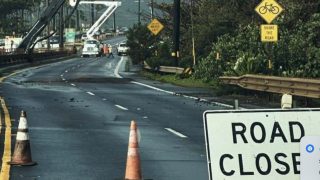
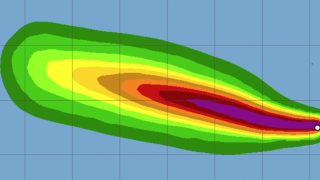
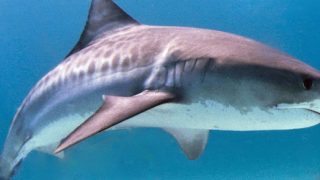
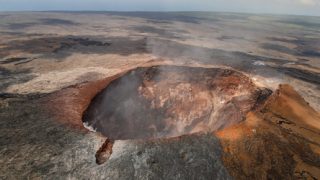
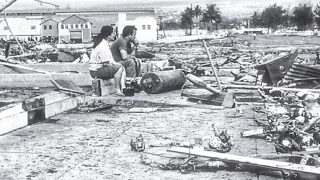
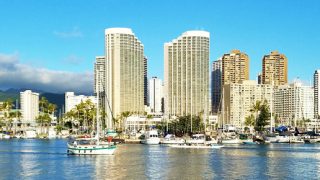
You are EXACTLY right; tsunami experts in Seattle couldn’t believe what Hawaii officials did: http://goo.gl/dKHg
Basically, they LIED, and almost nobody cares!
This was tantamount to screaming “fire”…if we would have known it 3 foot —NOT 12 FOOT like the officials told us here in downtown Hilo, we would have gone back to sleep.
Those of you who’d “rather be safe than sorry”, how ’bout we come wake you at 2:00 am and tell you that your house “might” catch on fire? I mean, it COULD, and wouldn’t you rather be SAFE?
Safe, shmafe —–GIVE US THE REAL FACTS NEXT TIME, and we’ll make up our own minds.
I have to disagree with you completely on this one. Tsunami are extremely unpredictable and are influenced by the shaking movement of the original earthquake and the geography of the ocean floor along its way, not just the distance from the epicenter. As a result, it can cause great damage in one area and very little damage in another. Also a six-foot surge like the one that hit the Marquesas could actually be quite serious and inundate coastal areas. You should have talked with a tsunami expert for your analysis, not relied on your layman’s assumptions about tsunami.
Great analysis! Next time, I will call you or check your blog/social media channels for accurate information.
Thanks for all the much appreciated comments and input!
Aloha, Rob
I was in Princeville, Kauai, HI. Very few comments on Local TV about Kauai, Lanai, Molikai. County & state authorities closed main road to Lihue from Princeville at Kapaa 9:30am didn’t reopen till 4pm.
Seems a lot of the fear is expressed by Govt authorities on Kauai, fearing they cannot control the 63,000 population, they isolate them without notice. Watching TV, other islands, Oahu, Maui, were told when roads would close, approx 1 hour before expected event. Not so on Kauai. No Notice.
It is always easy to be critical in hindsite. My first reaction to no Tsunami is “fantastic”. My second reaction to the “unnecessary panic” you speak of is “your damned if you do and damned if you don’t” when dealing with the public. Personally I would rather be safe than sorry. Any one that ignores a warning or drill in the future is just plan foolish.
My wife and I were staying at Hapuna Prince and were awakened at 6:00 am and were evacuated to higher ground by the resort and fed breakfast, lunch and even a complimentary dinner at the hotel later that night. Although the government messed up our last day by overblowing the tsunami I can not say enough good things about how Price Resorts handled the situation.